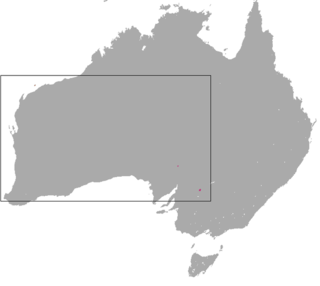
Original source: Base map derived from File:BlankMap-World.png. Distribution data from IUCN Red List
Author: Chermundy
Burrowing bettong
Order : Diprotodontia
Family : Potoroidae
Species : Bettongia lesueur
Keywords: white
The Boodie, burrowing bettong, lesueur's rat kangaroo is listed as Vulnerable (VU), considered to be facing a high risk of extinction in the wild, on the IUCN Red List of Threatened Species
Countries
AustraliaBurrowing bettong habitats
Grassland, Shrubland, Subtropical / Tropical Dry Grassland and Subtropical / Tropical Dry ShrublandSome facts about the
Burrowing bettong
Adult weight : 1.3 kg (2.86 lbs)
Female maturity :218 days
Gestation : 21 days
Weaning : 165 days
Litter size : 1
Interval between litters : 117 days
Weight at weaning : 0.3 kg (0.66 lbs)
Facts about the burrowing bettong
The type of Bettongia lesueur is from Dirk Hartog Island (where it is locally extinct).
The burrowing bettong is a nocturnal, vulnerable species . (Full text)
*** The burrowing bettong is the only burrowing species of the kangaroo family. (Full text)
Description The burrowing bettong is a marsupial and the only burrowing member of the kangaroo family though, as its other common name, the Lesueur’s rat kangaroo, indicates, it actually bears some resemblance to a rat. (Full text)
Endangered: The Burrowing Bettong is now increasing in numbers thanks to a concerted preservation effort.
Also referred to as a 'Boodie' the Burrowing Bettong is nocturnal, choosing to spend much of the day hidden away from heat and predators in its burrow.
Actually a miniature kangaroo, the burrowing bettong is the only member of the family to live year-round in burrows. (Full text)
Burrowing Bettong is potentially available in six (6) land systems in Cathedral Cave’s catchment and in five (5) land systems in Kenniff Cave’s catchment (Tables X.
Burrowing Bettong is a ground dwelling non-macropod that prefers tubers, bulbs, seeds, nuts, and green plants.
Burrowing bettongs are largely vegetarian and will dig for food using scent to guide them to the food. (Full text)
The species became extinct in mainland Australia in the 1940s and Burrowing Bettongs are now present naturally on only 5 off-shore islands in Western Australia.
Boodies (Burrowing Bettongs) are steadily increasing in number again after a period of little breeding activity. (Full text)
More animals beginning with B
